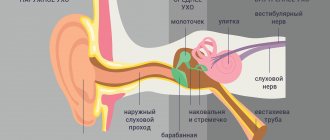A pinched nerve is most often not dangerous: rest and treatment will help relieve the compression and restore nerve function within a few days or weeks. But in rare cases, the situation is so serious that surgical intervention is necessary.
A pinched nerve is a condition in which too much pressure is placed on a nerve by nearby tissue. These can be muscles, cartilage, tendons, bones. As a result, the functioning of the nerve is disrupted. First of all, this is manifested by pain in the corresponding part of the body, as well as a decrease in muscle strength and tone, a feeling of numbness, tingling, and decreased sensitivity.
The most typical example of pinched nerves is compression of the spinal cord roots by a herniated disc. If this happens in the lumbar region, then sciatica usually occurs - pain that spreads along the back of the leg, along the sciatic nerve. Another fairly common condition is carpal tunnel syndrome, where the tissue in the wrist area swells and puts pressure on a nerve.
Nerve compression is a very common condition and one of the most common reasons for visiting doctors. According to American scientists, the pathology occurs in 85 people out of one hundred thousand adults. It can happen at any age, but most often occurs in people over 50 years of age. The most common cause is arthrosis and degenerative changes in the spinal column.
Why does pinched nerve occur?
The causes of compression of nerves in the body vary widely. Main risk factors:
- soft tissue injuries, bone damage;
- inflammation and swelling in surrounding tissues;
- herniated intervertebral discs;
- osteochondrosis, arthrosis of intervertebral joints and other degenerative changes in the spinal column;
- repeated frequent repetitive movements - for example, in people who type on a keyboard;
- intense physical activity, sports - especially if a person does it professionally;
- obesity – since extra pounds place increased stress on the joints and spine;
- rheumatoid arthritis is a disease that leads to inflammation in the joints and compression of nearby nerves;
- pregnancy - during it, body weight increases, the load on the musculoskeletal system increases and at the same time the connective tissue softens so that the woman’s pelvis can pass the fetus;
- diabetes mellitus - does not directly lead to nerve compression, but increases the risk of developing this condition;
- thyroid disease increases the risk of developing carpal tunnel syndrome;
- bone spurs (osteophytes) – growths on the bones that occur with degenerative joint diseases;
- prolonged bed rest;
- cicatricial changes in tissues after injuries, burns.
Another risk factor is gender. Women are more likely to experience carpal tunnel syndrome. This is probably due to the fact that their channel is normally narrower than that of men. Of course, heredity also plays a role. Some people are more likely to develop degenerative processes in the spine and joints - this is influenced by certain gene variants that affect the characteristics of connective tissue.
Characteristics of the work of an immunologist
An immunologist is a doctor whose focus is the treatment of diseases of the human immune system, as well as carrying out preventive measures regarding diseases and pathologies of the immune system, in order to minimize the consequences of immunological problems and their impact on the functioning of other important organs and systems of the patient.
Content:
- Characteristics of the work of an immunologist
- Symptoms and diseases
- Methods for diagnosing diseases by immunologists
- Recommendations from immunologists
Preventive immunization is not only a medical, but also a socially useful task for immunologists, which includes the timeliness of vaccination and the prevention of complications in the post-vaccination period.
Since the immune system takes an active part in the work of absolutely all organs and systems of the human body, an immunologist must very skillfully assess the impact of immune problems on the course of various processes.
Immunologists also work in research centers, studying the variability of diseases and developing the latest effective vaccines.
The main sections of immunology as a science are classified into separate specialized areas.
General immunology, which examines the molecular structure of human immune cells, pathological immunology or immunopathology, which examines disorders of the immune system of an individual patient, infectious, non-infectious immunology.
The list also includes immunochemistry, allergic immunology, which studies, prevents and eliminates allergic reactions.
Transplantation immunology considers the immunological aspects of organ transplantation, radiation immunology deals with the restoration of immunity after irradiation, embryoimmunology is aimed at determining the compatibility of the fetus and mother.
Pediatric immunology stands out separately, the task of which is to study the development of immunity in children, their timely immunization and the determination of specific methods of treating young patients.
Another global role of immunologists in modern medicine is direct participation in the development of vaccines against severe infectious diseases.
What symptoms should you look out for?
Pinched nerves can occur throughout the body, and the manifestation will depend on where the compression occurs. The most common conditions:
- Compression of the nerves of the neck is what is most often called cervical radiculopathy.
- Compression of nerves in the lumbar region is lumbar radiculopathy.
- Compression of the sciatic nerve – sciatica.
- Compression of the ulnar nerve.
- Carpal tunnel syndrome.
Let's look at the eight most common manifestations.
Pain or burning sensation spreading down the leg
The largest nerve in the human body, the sciatic, emerges from the lower part of the spine. It passes through the lumbosacral region, the buttock and then along the back of the entire leg. Its branches provide muscle movement and skin sensitivity. Compression of the sciatic nerve can be caused by such reasons as intervertebral hernias and spinal stenosis in the lumbar region, trauma, spondylolisthesis (a condition in which the upper vertebra seems to slip from the lower one), piriformis syndrome (when this pelvic muscle spasms and compresses the nerve) , tumors of the spinal column. In medical parlance, compression of the sciatic nerve is called sciatica or radiculopathy. It manifests itself in the form of pain along the back of the leg, along the nerve - dull, aching or sharp, like lumbago.
Pain radiating from the neck down the arm
Just as the sciatic nerve descends from the lumbar spine to the lower limb, the nerves of the arm are formed by roots that are located in the cervical spine. When they are squeezed, the pain spreads down the arm. Pain sensations can be localized in the area of the upper arms, upper arms, forearms, hands, and upper back.
In general, if we talk about compression of nerves caused by pathologies of the spine, the lumbar region most often suffers: it is located at the bottom, and it bears heavy loads. In addition, there is high mobility here. In second place is the cervical spine, due to its high mobility and the fact that it has to withstand the weight of the skull. In the thoracic region, disturbances occur much less frequently, because there is minimal mobility and the vertebrae are fixed by the ribs.
Weakness in the legs
While walking, the nerves of the lower extremities work at lightning speed. They must quickly transmit signals that cause specific muscle groups to contract and relax. Severe compression of the nerve leads to poor signal transmission. As a result, weakness occurs in the leg muscles, their tone decreases, and gait is disrupted. This is already quite a formidable symptom. Patients often describe it with the phrase: “Doctor, one of my legs literally drags while walking.”
Decreased hand grip strength
The nerves of the hands provide muscle contractions, precise coordination of movements, and fine motor skills. When pinched, these functions are disrupted, and the person notices that everything is literally falling out of his hands. Particularly difficult is when writing and performing other tasks that require small movements.
Feeling numb
In parallel with motor ones, sensory nerve fibers also suffer. They stop sending impulses to the brain, and a feeling of numbness occurs - like after an injection of an anesthetic, or “freezing” the mouth during dental treatment. In the most severe cases, sensitivity in a certain area is completely lost - this indicates that the nerve has suffered greatly.
Tingling feeling
Unpleasant sensations in the form of tingling, burning, and crawling sensations are called paresthesia in medical terms. They occur when the nerve is irritated and incompletely compressed. This feeling can be compared to the sensations in the hand when it was “rested” in a dream or after being hit with the elbow in the place where the nerve passes. Paresthesia in the hand is often the first sign of carpal tunnel syndrome.
Dysfunction of the rectum and bladder
The nerves that exit the lumbar spine control not only the muscles, but also the internal organs, in particular the bladder and rectum. Loss of control over urination and bowel movements indicates that the compression has caused severe nerve damage and the patient needs immediate medical attention. This condition may manifest as urinary and fecal incontinence or other disorders.
Pain that changes in intensity as the person changes position
Here sciatica can again be cited as a clear example. The patient usually feels better when he sits, leaning forward, or lies on his back. And in the position on the side, the pain syndrome, on the contrary, intensifies. This causes problems with sleep. When a person assumes a certain position to relieve pain, this is called antalgic position.
With malignant tumors and metastases in the spine, the pain is usually long-lasting, painful, and intensifies during rest and night sleep.
When do you need to see a doctor urgently?
The following symptoms should be the reason to immediately consult a doctor:
- very severe pain, especially if it occurs acutely after an injury;
- pain that does not go away within several days, despite the fact that the person kept rest and took painkillers;
- pain in the spine, arm, leg, which is accompanied by an increase in body temperature;
- deterioration of sensitivity, paresthesia, decrease in muscle tone, strength.
To understand the causes of nerve compression, the doctor may prescribe different diagnostic methods. The most commonly used are electroneuromyography (study of the passage of electrical impulses in nerves and muscles), ultrasound (preferably using a high-resolution device), computed tomography and magnetic resonance imaging.
Methods for diagnosing diseases by immunologists
The arsenal of immunologists includes a number of complex, highly productive biochemical and molecular studies.
Similar tests are performed in specialized laboratories, all of them are divided into groups - rheumatoid studies, autoimmune studies, indicators of general immunity, diagnosing celiac disease or antiphospholipid syndrome.
In addition, it is imperative to bring the results of a general analysis of blood, stool and urine to your appointment with an immunologist.
So, all tests are prescribed by an immunologist to make an accurate diagnosis.
For the same purpose, a doctor can use various methods for diagnosing diseases:
- tests for exposure to all kinds of allergens - plant pollen, household allergens, food allergens and others;
- conducting studies of immune status;
- studies of interferon status in the body;
- cytological methods - scrapings from the tonsils, tongue, ear canals to identify bacteria and fungi that cause the disease;
- conducting a stool test for intestinal dysbiosis;
- blood culture for sterility;
- cultures from the conjunctiva, throat, ears and nose;
- serological and molecular biological studies;
- diagnosis of various types of allergies;
- identifying changes in the number of heartbeats, pulse rates, and blood pressure.
Immunologists also conduct a general physical examination of the patient, including percussion, palpation, auscultation, as well as ultrasound examinations, X-ray readings, electrocardiography data, tissue biopsy results and much more.
How are pinched nerves treated?
The first measure in such cases is rest for the part of the body in which the pain is bothering. Your doctor may prescribe a splint to limit movement in the limb. For example, for carpal tunnel syndrome, such a splint is recommended to be worn around the clock.
Drug treatment is with nonsteroidal anti-inflammatory drugs (NSAIDs), such as ibuprofen or naproxen. These drugs help relieve pain in the acute period. If the pain is very severe, the doctor may prescribe injections of glucocorticosteroids - preparations of adrenal hormones. They have a more pronounced analgesic and anti-inflammatory effect.
After a period of immobilization, physical therapy begins. There are special exercises that help strengthen the muscles in the affected area or relieve their spasm. Due to this, compression is reduced. An exercise therapist may recommend changes in daily activities, such as avoiding certain repetitive movements. Physiotherapy and therapeutic massage are used.
Typically, if conservative treatment does not help within a few weeks or months, surgery is indicated. The type of surgery depends on where the nerve compression occurs and what is causing it. For example, this may include removing bone spurs, a herniated disc, or cutting a ligament to free a nerve for carpal tunnel syndrome.
Treatment
Depending on the established diagnosis, the doctor prescribes a treatment regimen. This may include the following:
- medications with antihistamine effect;
- enterosorbents;
- external preparations for treating the skin (ointments, gels, emulsions, creams);
- bronchodilators;
- sedatives;
- calcium gluconate injections;
- immunomodulators;
- hypoallergenic diet.
It is also necessary to give up bad habits, eliminate potentially dangerous allergens, and keep your home clean (regular wet cleaning is required).









